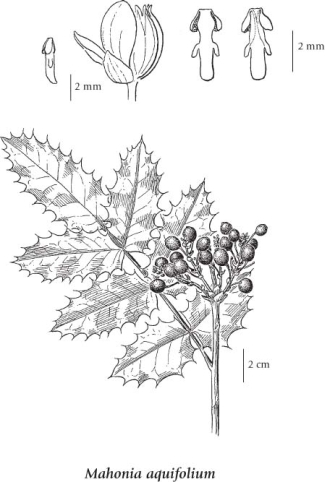tall Oregon-grape
Berberidaceae (Barberry family)
Introduction to Vascular Plants
Introduction
This lovely native evergreen shrub has thick dark green holly-like foliage on stems to about six feet tall. The buds begin to form in winter and open in early spring with bright clusters of yellow flowers. These are followed by deep blue ornamental fruits that mother robins feed to their young in my garden. The yellow pigment derived from the roots of this plant was used as a dye by First Nations peoples of British Columbia.
Note Author: Gary Lewis, Phoenix Perennials |
Species Information
General:
Evergreen shrub from a rhizome; stems branched, stoloniferous to stiffly erect, 0.5-2.5 (4.5) m tall; bark and wood yellowish.
Leaves:
Evergreen, hollylike, alternate, pinnate; leaflets usually 5-11, pinnately nerved, more than twice as long as broad, mostly with 12-29 prominent spiny teeth, shiny above but less so beneath.
Flowers:
Inflorescence of clustered racemes 3-8 cm long; flowers yellow, the segments in 6's.
Fruits:
Clustered berries 7-14 mm in diameter, blue, glaucous, with a few large seeds, edible.
Illustration

If more than one illustration is available for a species (e.g., separate illustrations were provided for two subspecies) then links to the separate images will be provided below. Note that individual subspecies or varietal illustrations are not always available.
Illustration Source: The Illustrated Flora of British Columbia
Ecology
The table below shows the species-specific information calculated from
original data (BEC database) provided by the BC Ministry of Forests and Range.
(Updated August, 2013)
| Site Information |
Value / Class |
||
|
Avg |
Min |
Max |
|
| Elevation
(metres) |
920 | 15 | 2400 |
| Slope
Gradient (%) |
28 | 0 | 240 |
|
Aspect (degrees) |
193 | 0 | 360 |
| Soil
Moisture Regime (SMR) [0 - very xeric; 4 - mesic; 8 - hydric] |
3 | 0 | 8 |
| Modal
Nutrient Regime
Class |
C | ||
| #
of field plots species was recorded in: |
4494 | ||
| Modal
BEC Zone Class |
IDF | ||
|
All BEC Zones (# of stations/zone) species was recorded in |
AT(1), BG(19), CDF(57), CWH(37), ESSF(42), ICH(1387), IDF(1849), MS(530), PP(146), SBPS(34), SBS(265) | ||
|
Source:
Klinkenberg 2013
|
|||
Habitat and Range
Mesic to dry open or closed forests in the lowland, steppe and montane zones; common in S BC; E to AB and S to ID and OR.Status Information
Synonyms
Synonyms and Alternate Names:
Mahonia aquifolium (Pursh) Nutt.
Taxonomic Keys
Taxonomic Key to Mahonia
1. Leaflets usually 9-19, palmately nerved.....................................M. nervosa 1. Leaflets usually 3-11, pinnately nerved 2. Leaves more than twice as long as broad, mostly with 12-29 prominent spiny teeth; leaflets 5-11; plants 0.5-4.5 m tall.......................M. aquifolium 2. Leaves less than twice as long as broad, with 15-43 inconspicuous, spiny teeth; leaflets 3-7; plant 0.1--.6 m tall.........................M. repens |